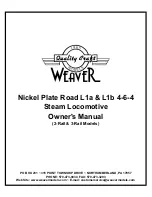
Wings Continued
36.
Slide ribs W3 over the wires and against each rib W2. Ensure that the etched triangle on
part W3 faces the outside of the assembly. Bond ribs W3 to ribs W2, then remove
alignment/jig wires. Lightly sand the top surface of the assembly then set aside until Final
Assembly.
Upper Wing Panels
37.
Create one W4 upper wing sheeting by fitting and bonding W4a and W4b together.
Important: Ensure etch marks on parts W4a/b are to a common side. Now, lay W4 on the
table with the etched surfaces facing
up
.
38.
Fit ribs W5, W6, and W7 in their designated positions (refer to plan and part W4 for correct
placement) with the arrows on the ribs pointing toward the leading edge. Tack glue the
trailing edge of each rib to the wing sheeting W4.
39.
Turn the wing over on a flat surface, and wrap the sheeting over the leading edge of the
ribs, engaging the tabs of the ribs in the slots in the sheeting. Tack glue at each tab and
notch location. Now, turn the wing back over and final bond the ribs by wicking medium CA
along all mating surfaces.
40.
Repeat
□ □
steps 37, 38, and 39 to build the opposite mirrored upper wing panel.
Upper Wing Panels
41.
Create one W8 lower wing sheeting by fitting and bonding W8a and W8b together.
Important: Ensure etch marks on parts W8a/b are to a common side. Fit W8c to W8 and
bond with thin CA. Now, lay W8 on the table with the etched surfaces facing
up
.
42.
Fit ribs W9, W10, W11, and W12 in their designated positions (refer to plan for correct
placement) with the arrows on the ribs pointing toward the leading edge. Tack glue the
trailing edge of each rib to the wing sheeting W8.
43.
Turn the wing over on a flat surface, and wrap the sheeting over the leading edge of the
ribs, engaging the tabs of the ribs in the slots in the sheeting. Tack glue at each tab/slot.
Turn the wing back over and final bond the ribs by wicking thin CA along all mating
surfaces.
44.
Repeat
□ □
steps 41, 42, and 43 to build the opposite mirrored lower wing panel.
Finishing the Wing Panels
45.
This is a critical step to your success with this model. Don’t overlook it. Inspect each wing
panel to ensure it is warp free by laying each panel along your flat work surface. If the
bottom surface of the ribs will not sit flat atop your work table you’ve got a warp. Now is the
time to correct this warp.
To correct a warped panel heavily mist the top and bottom surface of the panel with glass
cleaner then pin or tape the moistened panel at the outer most ribs (not along the un-
supported sheeting) to your work table and allow to dry completely.
Sand wing panels lightly to remove any wood grain that is raised as a result of this
treatment.
Build Instructions
Fly Baby Bipe UM Build Instructions. © 2012 Stevens AeroModel all rights reserved.
!
Page 18
□
□ □
□ □
□ □
□
□ □
□ □
□
□ □
□














































